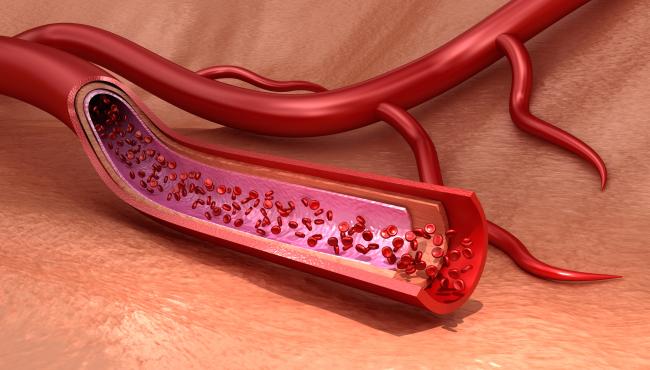Minoxidil may improve blood vessel structure
March 20, 2018
Minoxidil may improve blood vessel structure
At a Glance
- In mice, the drug minoxidil changes blood vessel structure, reducing vessel stiffness and increasing blood flow to the brain.
- The findings pave the way for studies of the drug’s potential as a treatment for older adults and others who have health problems resulting from blood vessel stiffness.

Elastic fibers in the walls of large blood vessels enable them to bounce back after being stretched. The diameter of vessels is controlled by both the amount of elastic fibers present and the degree of squeezing from smooth muscle cells in the vessel walls. A larger diameter allows more blood through. As adults age, their blood vessels slowly begin to lose flexibility. The increased vessel stiffness and reduced vessel diameter that result contribute to the aging-related risk of heart attack, stroke, and dementia. There are also rare diseases that can cause lifelong vessel stiffness from insufficient elastic fibers.
The dozens of drugs on the market for reducing blood pressure work in very different ways. Minoxidil, which also promotes hair growth when used on the scalp, can relax the smooth muscle cells in blood vessels by opening certain potassium channels. Prior studies with animals suggested that another function of the drug is to turn on the genes for elastin (a protein found in elastic fibers) and other elastic fiber genes, such as Fbn-1 and Lox, causing elastin deposits within the blood vessel wall.
To find out whether an oral form of minoxidil can remodel the vessel’s wall to reduce blood vessel stiffness and enhance blood flow to the brain, researchers studied the drug’s effects in mice. The team was led by Dr. Beth A. Kozel of NIH’s National Heart, Lung, and Blood Institute (NHLBI) and Washington University School of Medicine’s Dr. Joel R. Garbow and Dr. Michael Shoykhet (now at Children’s National Hospital). The study was also funded in part by NIH’s National Institute of Neurological Disorders and Stroke (NINDS). Results were published online on March 2, 2018, in the American Journal of Physiology—Heart and Circulatory Physiology.
The research team studied mice that were genetically modified to have low levels of elastin in their blood vessels. As a result, the mice had high blood pressure, increased blood vessel stiffness, and reduced blood flow to the brain. One group of modified mice received minoxidil in their drinking water from weaning until 3 months, a second group was treated for only the two weeks before elastin gene studies, and a third group had plain water instead.
The scientists found that minoxidil lowered blood pressure and vessel stiffness to levels similar to healthy mice. Imaging tests showed that vessel diameter and blood flow to the brain increased in the minoxidil-treated mice. One month after the drug was stopped, the diameter was still enlarged, suggesting that the structure of the blood vessel walls had changed. Using protein analyses and tissue studies, the team showed that minoxidil increased elastin deposits in blood vessels. Gene studies revealed that minoxidil revs up not only elastin and elastic fiber genes but also more than 100 other genes related to blood vessel structure.
Taken together, the findings suggest that treatment with minoxidil lowers blood pressure in part by remodeling large blood vessel walls. The structural changes reduce stiffness, increase blood vessel diameter, and improve blood flow to the brain.
“These results in mice are promising,” Kozel says. “We are looking forward to future clinical trials to test how this medication impacts blood flow in people.”
—by Geri Piazza
Related Links
- How Too Little Potassium May Contribute to Cardiovascular Disease
- Bioengineered Blood Vessel Grafts Grow in Animals
- Blood Pressure Management for Seniors
- Healthy Body, Happy Heart
- Atherosclerosis
- Minoxidil
- High Blood Pressure—Medicines to Help You


